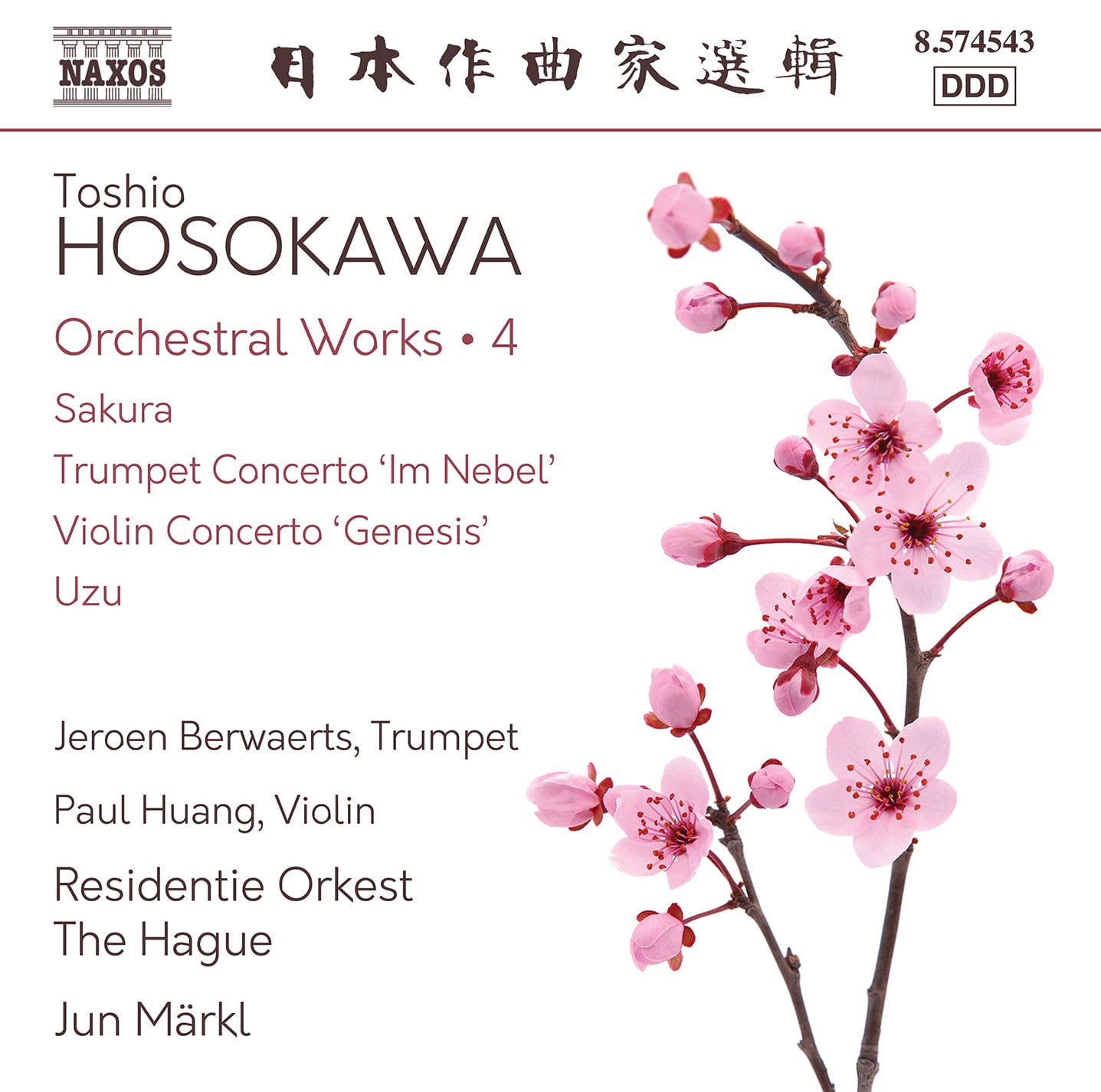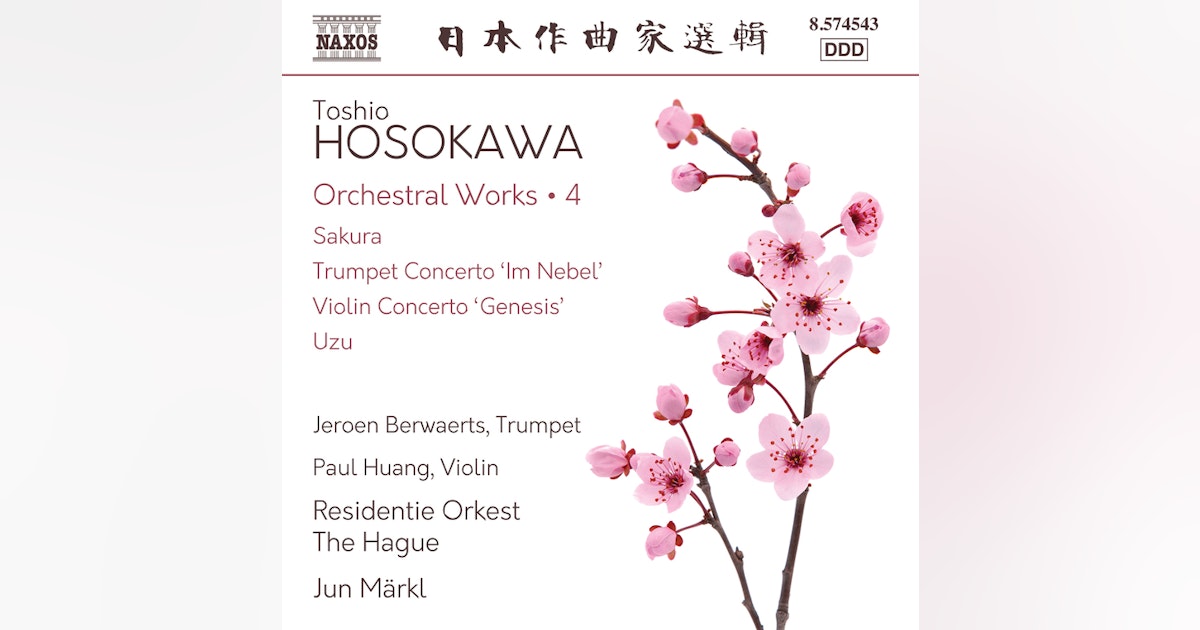Meet Toshio Hosokawa

Sometimes described as Japan's leading composer, Toshio Hosokawa (born 1955) s a composer whose scores, while Modernist, exude beauty. The Naxos series of his works is significant: it has been over a decade since I reviewed a disc of his music (the previous one was on Neos, and received for the Cambridge journal Tempo).
Think of Japan, think Mount Fuji, think ... cherry blossoms. The short piece Sakura (the Japanese word for cherry blossom) was commissioned by the Bamberg Symphony and also exists with the German isle Kirschblüte). The popular song on which Hosokawa's piece is based (Sakura, Sakura) has been around since the Meiji period. Cheery blossoms are associated with Spring in Japan (they are a significant aspect of the national consciousness!) and the song itself is beautiful. Here is the traditional song in a rather lovely performance; lyrics and translation can be found at the song's Wikipedia page:
That sam Wikipedia article points ou that the song has been used by many, including Bon Jovi in Tokyo Road:
Hosokawa's 2021 piece begins elusively, quietly. A perfect fifth in teh lower strings pervades the piece; the emergence of the song melody is gradual, and beautifully managed here. with the full orchestral statement, its statements of "sakura" intermingled with Modernist gestures:
There are other versions of Sakura by Hosokawa. Here's Hosokawa's take on the song for shõ (a Japanese wind instrument descended from teh Chinese Sheng), a hauntingly beautiful sound. The 2008 piece is called Sakura für Otto Tomek, and :was an 80th birthday celebration for Tomek:
and here's a version of Hosokawa's Sakura for guitar, beautifully played by Timo Korhonen:
The Concerto for Trumpet and Orchestra of 2012 is subtitled, ‘Im Nebel’ (text here: the link also includes audio of someone speaking the poem in German; an translation into English is here). Mist, fog, is used as a metaphor for isolation. In Hookawa's concerto, the trumpet is the human, the orchestra Nature. It has been suggested the piece is a ‘Shan shui’ in sound: Shan shui is a type of Chinese Nature painting using brush and line (Wikipedia article: “Shanshui” - 山水 - means landscape, or more literally “mountain water”).
A visual equivalent to this piece has been suggested as the pine tree art of Hasegawa Tōhaku (1539–1610) in which the trees are subsumed into mist. Below is a detail from one of the paintings, made with ink wash:

This has to be the most beautiful trumpet concerto in the repertoire. Jeroen Berwaerts is a consummate soloist, his technique infinitely strong and accurate, infinitely pliable in his realisation of Hosokawa's beautiful lines. The slow dissolution of solo line (Man) into the overall orchestral texture (orchestra) is incredibly moving, partially because it is so perfectly done here:
Another concert now: the Violin Concerto, ‘Genesis,’ of 2020.Paul Huang is the soloist and once more Märkl inspires the Resident Orkest The Hague to moments of user beauty. The premiere was conducted by Kent Nagano, a conductor we have referenced several times on Classical Explorer. The soloist then was Verokika Eberle, who in 2019 gave birth: once ‘Genesis’. Again, solost is aligned as an individual against the universal forces of the orchestra. The both correlatives are quite detailed: the wave motions of teh orchestra at the opening suggest amniotic fluid; the violin's melodies 'grow' in reference to the life around them (the orchestra). A process of growing up is described, in which teh violin, whlle initially imitating teh orchestra, rebels and finds an independence as a result. There is a sense of a traditional cadenza (the third section, Tempo rubato), but this is cadenza as an extension of a narrative rather than pre-destined virtuoso solo break. Paul Huang is a superb violinist, very true of pitch and uncooked by Hosokawa's technical demands (track 5). Shortly thereafter, in a section called ‘Solo & Duo,’ that idea of a cadenza extends itself to a cadenza for two (violin and unnamed flautist in this instance).
This is a World Premiere recording. Here is an introducory video from Naxos:
Here's that “Solo & Duo,” plus the orchestra's roiling aftermath:
The piece ends with a high song without words for violin, ever ascending until it merges with its surroundings. Huang and Märkl's way with this is unutterably beautiful:
Although this is a World Premiere of the Violin Concerto on disc, there is a YouTube of the premiere which very, very usefully includes scrolling full score:
Finally, Uzu for orchestra of 2019, another World Premiere recording (three out of four pieces here are: only the Trumpet Concerto is available elsewhere). Uzu is dedicatd to the composer's friend Jun Märkl. The title, 渦 (Uzu) can be translated as vortex, or a swirl, or an eddy. This in turn references the shõ (we met it above) and its techniques of circular breathing, of inhalation and exhalation. The idea of a spill of breathing is at the base of this work. Shards emerge from waves of sound and are returned to it: Hosokawa offer a liminal space striving for identity. he gives himself time in which to achieve this (24 minutes in this performance).
The piece uses the idea of a canon taken from the music of the Japanese Imperial Court, Gagaku, a technique called ‘Oibuki’. It is not the only piece to do so, incidentally: the first movement of the First Symphony of Qunihico Hashimoto (1904-1949) uses it too.
Here's that Hashimoto Symphony, and Naxos' notes for it are available at this link:
... you can read my review of the Numajiri Naxos disc on Musicweb-Internaional here, and finally, so you can get the idea of what Gagaku actually sounds like, here's an hour of it:
A fascinating disc of music by Toshio Hosokawa: may many more follow.
The Naxos Hosokawa disc is available on Amazon here; the Hashimoto Symphony disc is available, somewhat bizarrely, at Amazon here for £5.23 (itself an odd amount) and here for a whopping £105.29 (instalment plans are available, we are assured!).



